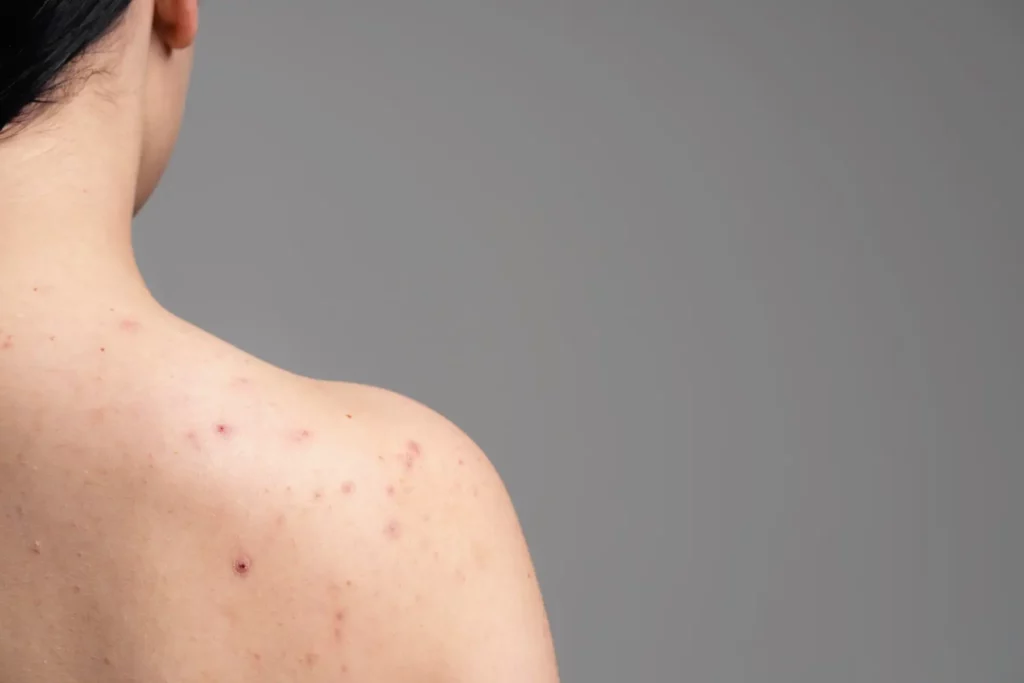Do you have tiny red, pus-filled bumps on your skin? You could be dealing with folliculitis–a common skin condition characterised by inflammation or infection of the hair follicle. But what is folliculitis, what causes it, and how can you get rid of it?
What is folliculitis?
Folliculitis is a common skin condition that affects people of all ages and genders. But some factors can make you more likely to get folliculitis. Some risks include:
- If you shave frequently
- If you have been using an oral antibiotic for a prolonged period
- If you are overweight or obese
- If you have a history of diabetes
- If you engage in a lot of sweat-inducing activities and do not fully clean off afterwards
- If you use a hot tub or sauna that is not properly maintained
The condition develops when the hair follicles become inflamed or infected by bacteria, causing small red bumps, itching, and discomfort. You can get these tiny bumps on your face, arms, back, neck, scalp and legs.
What are the causes of folliculitis?

Here are some common factors that can contribute to the development of folliculitis:
- Bacterial infection
Bacterial infection is the leading cause of folliculitis. The condition is frequently caused by Staphylococcus aureus, a type of bacteria that can be found on the skin. It can also be brought on by other bacteria, notably in hot tubs and swimming pools, such as Pseudomonas aeruginosa.
- Fungal infection
It may also result from dermatophyte or yeast infections, such as Candida. The groin area is particularly susceptible to these conditions since they frequently develop in warm, humid conditions.
- Ingrown hairs
Ingrown hairs may develop from clogged or inflamed hair follicles, which can cause folliculitis. This typically happens in regions where hair is regularly waxed or shaven.
- Viral infection
Viral folliculitis is a particular type of folliculitis that can be brought on by infections like herpes simplex or varicella-zoster.
What are the common symptoms of folliculitis?
Here are some common symptoms of this skin condition:
- Small, red bumps or pustules around hair follicles
- Itching or a burning sensation
- Tenderness
- Pain
- Inflamed or swollen skin
- Formation of crusts or scabs
- Development of white-headed pimples
- Occasionally, the presence of pus or fluid-filled blisters
What are the best folliculitis treatment options?

Folliculitis treatment depends on the underlying cause and severity of the condition. The severity and type of folliculitis you have will determine your folliculitis treatment options. While some types may require more intensive care, others might recover on their own with little to no treatment. At times, if your folliculitis is mild, it can be treated at home. Here are some common treatment options:
- Medication
It caused by viral or fungal infection can be treated with the help of medication. Some common types of medications include:
- Topical antibiotic creams
- Oral antibiotics
- Topical antifungal creams
- Antifungal shampoos
- Oral antifungals
- Steroid creams
- Oral corticosteroids
- Light therapy
Did you know that photodynamic therapy is an excellent folliculitis treatment option? It is proven to improve the symptoms of deep folliculitis and prevent tiny bumps from coming back.
- Laser hair removal
Laser hair removal is an effective folliculitis treatment. It minimises folliculitis, which is brought on by repeated shaving. Because the hair follicles are destroyed, bacteria, fungus, or viruses are no longer able to infect them.
With the right approach and a personalised treatment plan, you can achieve healthy and clear skin, free from the discomfort of folliculitis. So, if you wish to learn more about folliculitis treatment options, schedule a consultation with me here.
